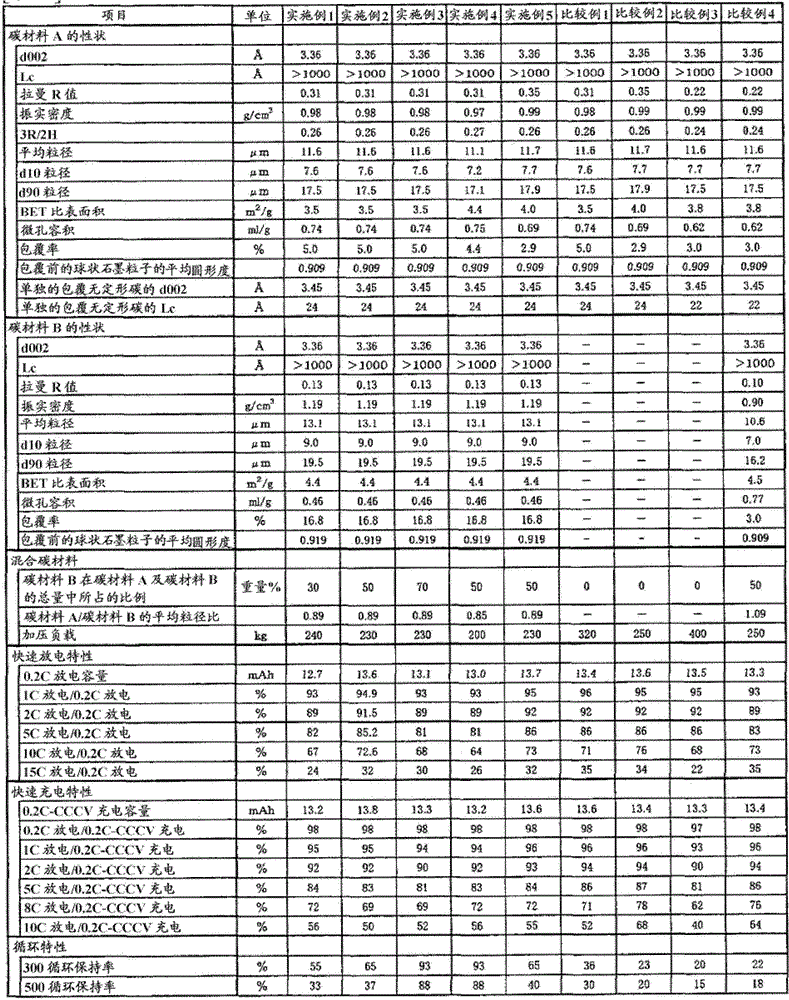Negative electrode material for non-aqueous electrolyte secondary battery and non-aqueous electrolyte secondary battery using same
A non-aqueous electrolyte and secondary battery technology, applied in the direction of secondary batteries, battery electrodes, negative electrodes, etc., can solve the problem of increasing the irreversible capacity of amorphous carbon particles, and achieve rapid charge and discharge characteristics, excellent performance, and high cycle characteristics Effect
- Summary
- Abstract
- Description
- Claims
- Application Information
AI Technical Summary
Problems solved by technology
Method used
Image
Examples
Embodiment 1
[0176] (Production of Carbon Material A)
[0177] As the raw material graphite, the following natural flaky graphite particles were used: The interplanar distance (d002) of the 002 plane measured by the wide-angle X-ray diffraction method was 3.36 , Lc is 1000 Above, the tap density is 0.46g / cm 3 , 1360cm in argon ion laser Raman spectrum -1 Nearby peak intensity is 1580cm -1 The ratio of the nearby peak intensity, that is, the Raman R value is 0.13, the average particle size is 28.7μm, and the true density is 2.27g / cm 3 .
[0178] Using the Hybridization System manufactured by Nara Machinery Manufacturing Co., Ltd., the scaly graphite particles were continuously processed at a processing speed of 20 kg / hour under the conditions of a rotor peripheral speed of 60 m / sec and 10 minutes. The surface of the graphite particles was spheroidized while being damaged. Then, the fine powder is removed by performing classification treatment.
[0179] The obtained spherical graphite carbon is ...
Embodiment 2
[0202] The same operation as in Example 1 was performed except that the ratio of the carbon material B in the total amount of the carbon material A and the carbon material B was 50% by weight. The results are shown in Table 1.
Embodiment 3
[0204] The same operation as in Example 1 was performed except that the ratio of the carbon material B to the total amount of the carbon material A and the carbon material B was 70% by weight. The results are shown in Table 1.
PUM
| Property | Measurement | Unit |
|---|---|---|
| density | aaaaa | aaaaa |
| specific surface area | aaaaa | aaaaa |
| particle size | aaaaa | aaaaa |
Abstract
Description
Claims
Application Information
 Login to View More
Login to View More - R&D
- Intellectual Property
- Life Sciences
- Materials
- Tech Scout
- Unparalleled Data Quality
- Higher Quality Content
- 60% Fewer Hallucinations
Browse by: Latest US Patents, China's latest patents, Technical Efficacy Thesaurus, Application Domain, Technology Topic, Popular Technical Reports.
© 2025 PatSnap. All rights reserved.Legal|Privacy policy|Modern Slavery Act Transparency Statement|Sitemap|About US| Contact US: help@patsnap.com

